The myth is that maybe it’s pretty accurate that human beings are always searching for new tastes, like discovering anything new in life or exciting new things, such as tasty fruits or foods. So imagine biting into a juicy, unique color fruit you have never seen or tasted.
When you first bite and taste sweet, tangy, maybe even a little spicy, that’s the tasty magic of exotic fruit in season now. Exotic fruits are not just pretty to look at or taste; they are full of nutrition, benefits, and unique stories from faraway lands.
Therefore, this blog features exotic fruits in season now and throughout the year, along with their unique textures and nutrition facts. You can also learn what’s fresh and delicious right now, where to find it, and how to enjoy it.

- Why Exotic Fruit in Season Now Matters:
- Top Exotic Fruits in Season Right Now (Spring to Summer):
- More Exotic Fruits in Season Now at Fruit & Spice Park (Florida):
- Year-Round Availability of Exotic Fruits:
- Step-by-Step: How to Shop for Exotic Fruits:
- Storage Tips for Exotic Fruits:
- Buying Exotic Fruit Online:
- A Sustainable Way to Enjoy Exotic Fruits:
- Taste the Adventure of Exotic Fruits:
- Frequently Asked Questions (FAQs):
Why Exotic Fruit in Season Now Matters:
You are self-witnessed whenever you walk through a local Asian or Latin market and see unique-looking fruits with spiky skins, unusual shapes, or bright pind peels. Oh my goodness, don’t be surprised, as those are exotic fruits. The exotic fruits mainly belong to Southeast Asia, South America, and the Caribbean. While many used to be challenging to find, today, you can spot them in your local grocery stores or fruit markets.
So, eating fruits in season matters because they are on the pick of their taste, texture, and nutrients. But the most unique factor is that they are usually more affordable and eco-friendly because exotic fruits do not have to travel far out of season unless involving technology. So, buying exotic fruit is not just buying a fruit; you are trying something that could become your new favorite food.
Top Exotic Fruits in Season Right Now (Spring to Summer):

1. Dragon Fruit (Pitaya):
When you travel Vietnam’s Mekong Delta region, while walking randomly, you always witness a market vendor slicing open a hot pink fruit that looks like a fireball. The fruit inside speckled white flesh that tastes like a pear with a twist. Yes, you guessed right, it is an exotic dragon fruit.
Dragon Fruit Season: Start Late spring and continue through summer.
Dragon fruit Taste: Its taste is Mildly sweet with a kiwi-like crunch.
How to eat: Slice it open and scoop out the flesh.
Quick tip: Choose one that’s evenly colored with a slight softness to the skin.

🐉 Dragon Fruit (Pitaya) – Nutrition Facts & Health Benefits:
| Nutrient (per 100g) | Amount | Health Benefits |
| Calories | ~50–60 kcal | Low-calorie, great for weight management |
| Carbohydrates | 11–13 g | Provides quick energy |
| Sugars | 8–9 g | Natural fruit sugars; better than refined sugar |
| Dietary Fiber | 3 g | Aids digestion and supports gut health |
| Protein | 1–1.5 g | Supports muscle repair and growth |
| Fat | 0.1–0.6 g | Very low in fat |
| Vitamin C | 3–6 mg (5–10% DV) | Boosts immunity and collagen production |
| Calcium | 6–10 mg | Supports bone health |
| Iron | 0.3–0.7 mg | Helps with oxygen transport in blood |
| Magnesium | 18–23 mg (6–8% DV) | Supports nerve and muscle function |
| Antioxidants | Betalains, Flavonoids | Protects cells from free radicals, may reduce inflammation |
2. Rambutan Fruit:
The next exotic fruit we have looks like a hairy strawberry, but do not be afraid because a common myth is” Do not judge a book from its cover.” These words fit on this fruit; you know it’s an exotic rambutan fruit. While traveling in Malaysia, you can find rare rambutan fruit. The fruit inside is a juicy white with a lovely, sweet, sour taste.
Rambutan fruit Season: The fruit starts at the end of spring to early fall
Rambutan fruit taste: Sweet and slightly tart
How to eat: Peel off the hairy skin and eat the flesh around the seed.
Fun fact: The word “rambutan” means “hair” in Malay!
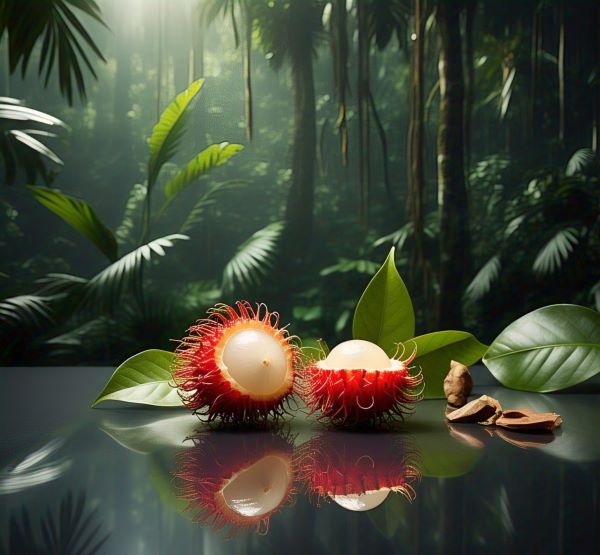
. 🍊 Rambutan Nutrition and Benefits:
| Nutrient (per 100g) | Amount | Health Benefits |
| Calories | ~68–75 kcal | Moderate energy source |
| Carbohydrates | 16–18 g | Quick energy boost |
| Sugars | 13–15 g | Natural sugars for sweetness |
| Dietary Fiber | 2–3 g | Aids digestion, prevents constipation |
| Protein | 0.7–1 g | Minor protein source |
| Fat | 0.2–0.5 g | Very low fat content |
| Vitamin C | 20–30 mg (30–40% DV) | Strong immunity booster |
| Calcium | 10–15 mg | Supports bones and teeth |
| Iron | 0.3–0.5 mg | Helps prevent anemia |
| Magnesium | 10–15 mg (3–5% DV) | Supports muscle and nerve function |
| Antioxidants | Polyphenols, Gallic Acid | Fights oxidative stress, may reduce inflammation |

3. Exotic Fruit Mangosteen:
The Thai people call this fruit “The Queen of fruits.” Yes, you are right. We are talking about the exotic mangosteen fruit. The taste of mangosteen, which is also called purple mangosteen, is tangy, sweet, juicy, and somewhat fibrous. When ripe, it becomes fluid-filled vesicles, with an inedible, fully reddish-purple rind.
The mangosteen fruit is native to Southeast Asia, Southwest India, and other tropical climate regions, such as Colombia and Florida.
Mangosteen Fruit Season: It starts in May and ends in September.
Mangosteen Taste: The fruit tastes Sweet, tangy, and floral.
How to eat: Press gently to open and enjoy the juicy segments.
Pro tip: Avoid ones with hard shells—they’re overripe.
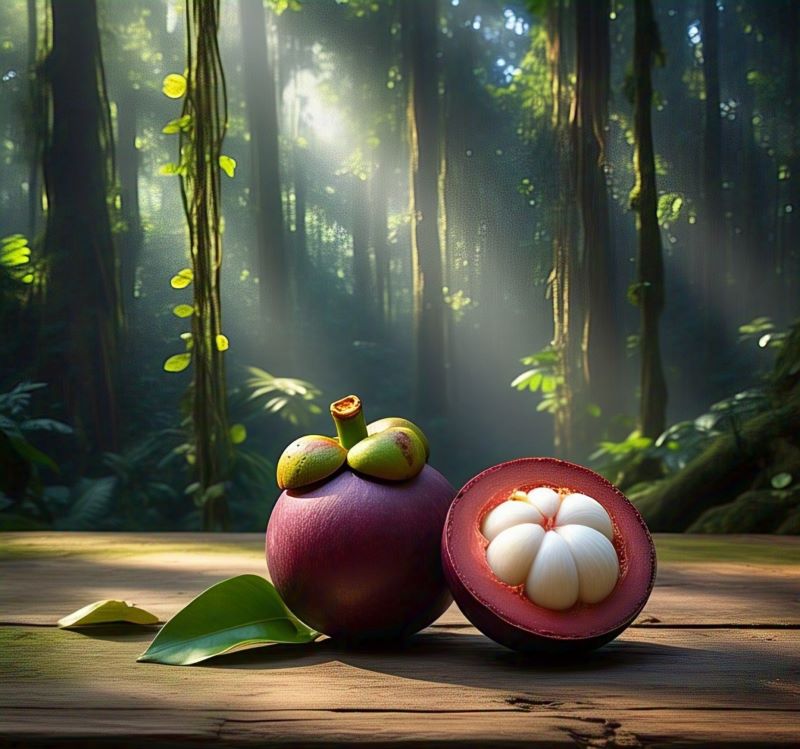
Mangosteen Fruit Nutritional Elements and Benefits:
| Nutrient (per 100g) | Amount | Health Benefits |
| Calories | ~60–75 kcal | Low-calorie, weight-friendly |
| Carbohydrates | 15–18 g | Sustained energy release |
| Sugars | 12–14 g | Natural fructose for energy |
| Dietary Fiber | 5–6 g | Excellent for gut health |
| Protein | 0.5–1 g | Minimal protein content |
| Fat | 0.1–0.4 g | Almost fat-free |
| Vitamin C | 5–7 mg (8–12% DV) | Immune support, skin health |
| Calcium | 5–10 mg | Minor bone support |
| Iron | 0.2–0.4 mg | Helps in red blood cell formation |
| Magnesium | 13–18 mg (4–6% DV) | Relaxes muscles, reduces cramps |
| Antioxidants | Xanthones, Tannins | Potent anti-inflammatory, may fight cancer |

4. Exotic Durian Fruit:
Now, it’s time to familiarize yourself with the king of the exotic durian fruit. In some regions, people call it the “king of fruits” because if you wish to have a custard from heaven, you must eat Durian fruit. The noticeable thing about durian fruit is its pungent smell. Some people find it pleasant, but some find it unpleasant. That is why durian fruit is banned in some South Asian regions because of its strong odour, which may linger for several days.
The color of its husk is green to brown, and its flesh is pale yellow to red, depending on the species. The fruit tastes like a complex mix of sweet, creamy, nutty, and even savory, and it also tastes like vanilla, caramel, or even a blend of garlic.
Durian fruit Season: June to September
Taste: Creamy, rich, like almond custard
How to eat: Open carefully (it’s spiky!) and eat the soft flesh inside.
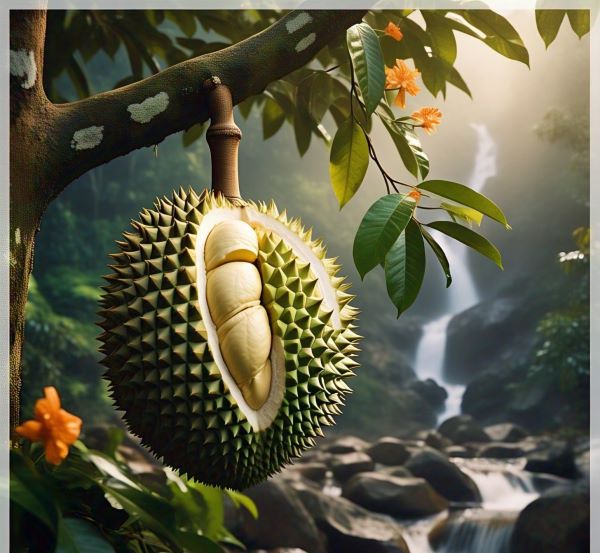
Durian Fruit Nutrition and Benefits:
| Nutrient (per 100g) | Amount | Health Benefits |
| Calories | ~135–150 kcal | High-energy fruit |
| Carbohydrates | 27–30 g | Great for instant energy |
| Sugars | 12–15 g | Natural sugars with fiber |
| Dietary Fiber | 3–4 g | Supports digestion |
| Protein | 2–3 g | More protein than most fruits |
| Fat | 3–5 g | Healthy fats for metabolism |
| Vitamin C | 20–25 mg (30–40% DV) | Strong antioxidant |
| Calcium | 6–10 mg | Minor bone benefits |
| Iron | 0.4–0.6 mg | Helps prevent fatigue |
| Magnesium | 25–30 mg (8–10% DV) | Supports heart and nerves |
| Antioxidants | Organosulfur Compounds | May lower cholesterol, anti-cancer properties |
5. Soursop (Graviola):
The soursop fruit is native to Central and South America and cultivated in other tropical areas of South Asia. The fruit is commonly called soursop because of its slightly acidic taste when ripe; the taste of the fruit is sweet and tangy and tastes like a mixture of strawberries and pineapple flavor.
Soursop Fruit Season: June to September
Taste: Like strawberry, banana, and pineapple combined.
How to eat: Scoop out the white flesh and avoid the seeds.
Tip: With soursop fruit, you can Make amazing smoothies and ice cream.
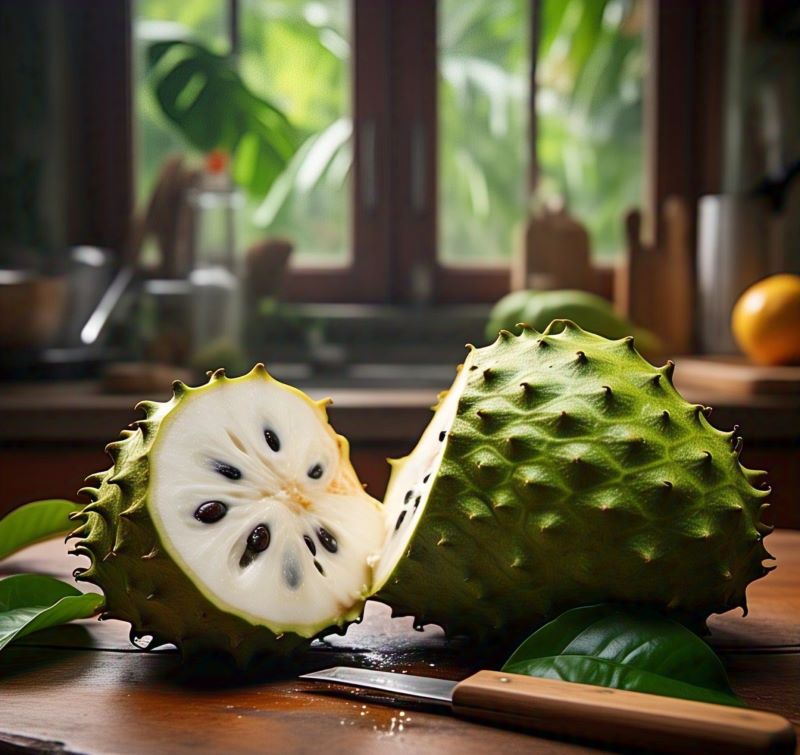
Soursop (Graviola) Nutrition and Benefits:
| Nutrient (per 100g) | Amount | Health Benefits |
| Calories | ~60–70 kcal | Low-calorie, good for diets |
| Carbohydrates | 15–17 g | Slow energy release |
| Sugars | 13–14 g | Natural sweetness |
| Dietary Fiber | 3–4 g | Aids digestion, prevents bloating |
| Protein | 1–1.5 g | Minor muscle support |
| Fat | 0.3–0.6 g | Very low fat |
| Vitamin C | 20–25 mg (30–40% DV) | Boosts immunity, collagen |
| Calcium | 10–15 mg | Supports bones |
| Iron | 0.5–0.8 mg | Helps with anemia |
| Magnesium | 20–25 mg (6–8% DV) | Reduces muscle cramps |
| Antioxidants | Acetogenins, Quercetin | May have anti-cancer effects, fights inflammation |
6. Jackfruit:
Do you know that the largest fruit of a tree is the Jackfruit? Yes, you are right. It usually weighs around 55 kg (120 pounds). The Jackfruit is native to tropical climates like Srilanka, Bangladesh, India, and the rainforests of Malaysia, the Philippines, Indonesia, and Australia. It tastes like sweet bananas, and its texture is meat-like, even called “vegetable meat.”
Jackfruit Season: March to June
Jackfruit Taste: Sweet, like banana and bubblegum.
How to eat: Open carefully and remove the yellow pods.
Bonus: Unripe Jackfruit is great for savory dishes and even vegan pulled pork.”
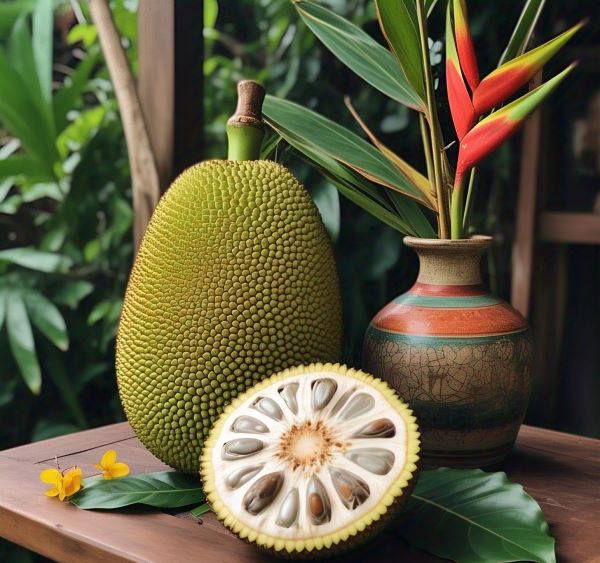
🍍 Jackfruit Nutrition and Benefits:
| Nutrient (per 100g) | Amount | Health Benefits |
| Calories | ~90–100 kcal | Moderate calories, filling |
| Carbohydrates | 22–25 g | Good energy source |
| Sugars | 15–18 g | Natural sugars with fiber |
| Dietary Fiber | 2–3 g | Supports digestion |
| Protein | 1.5–2 g | More protein than average fruit |
| Fat | 0.2–0.5 g | Very low fat |
| Vitamin C | 10–15 mg (15–20% DV) | Immune booster |
| Calcium | 20–30 mg | Strengthens bones |
| Iron | 0.5–0.7 mg | Helps oxygen transport |
| Magnesium | 30–35 mg (10% DV) | Supports heart health |
| Antioxidants | Carotenoids, Flavonoids | Anti-aging, reduces oxidative stress |
More Exotic Fruits in Season Now at Fruit & Spice Park (Florida):
If you live in Florida or are planning to visit, Fruit & Spice Park is home to hundreds of exotic plants. Here’s a quick look at what’s in season now:
- May: Bilimbi, African Grapes, Macadamia Nut, Red Velvet Banana
- June: Wax Jambu, Calamondin, Orange Berry, Peach
- July: Longan, Ice Cream Bean, Mango, Pineapple
Explore more monthly harvests on the park’s website.
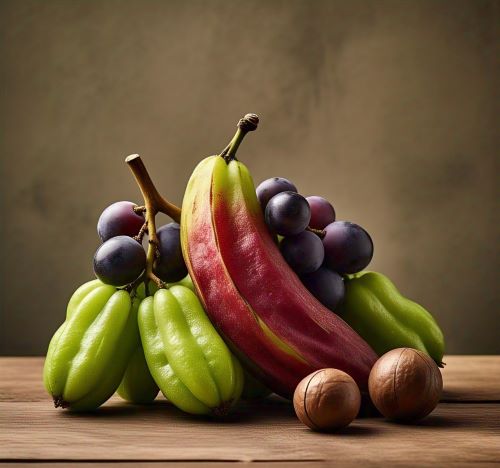
Year-Round Availability of Exotic Fruits:
✔ = Peak Season.
| Fruit | Jan | Feb | Mar | Apr | May | Jun | Jul | Aug | Sep | Oct | Nov | Dec |
|---|---|---|---|---|---|---|---|---|---|---|---|---|
| Avocado | ✔ | ✔ | ✔ | ✔ | ✔ | ✔ | ✔ | ✔ | ✔ | ✔ | ✔ | ✔ |
| Coffee | ✔ | ✔ | ||||||||||
| Ross Sapote | ✔ | |||||||||||
| Star Fruit | ✔ | ✔ | ||||||||||
| Loquat | ✔ | ✔ | ||||||||||
| French Chestnut | ✔ | |||||||||||
| Monstera | ✔ | |||||||||||
| Ylang Ylang | ✔ | |||||||||||
| Cinnamon Apple | ✔ | |||||||||||
| Blue Grapes | ✔ | |||||||||||
| Jujube | ✔ | |||||||||||
| Soursop | ✔ | ✔ | ✔ | ✔ | ||||||||
| Mamey | ✔ | |||||||||||
| Candlenut | ✔ | |||||||||||
| Mulberry | ✔ | |||||||||||
| Sweet Tamarind | ✔ | |||||||||||
| Bilimbi | ✔ | |||||||||||
| African Grapes | ✔ | |||||||||||
| Macadamia Nut | ✔ | |||||||||||
| Red Velvet Banana | ✔ | |||||||||||
| Wax Jambu | ✔ | |||||||||||
| Calamondin | ✔ | |||||||||||
| Orange Berry | ✔ | |||||||||||
| Peach | ✔ | |||||||||||
| Longan | ✔ | |||||||||||
| Ice Cream Bean | ✔ | |||||||||||
| Mango | ✔ | |||||||||||
| Pineapple | ✔ | |||||||||||
| Dragon Fruit | ✔ | ✔ | ✔ | ✔ | ✔ | |||||||
| Coconut | ✔ | |||||||||||
| Jackfruit | ✔ | ✔ | ✔ | |||||||||
| Sapodilla | ✔ | |||||||||||
| Spanish Limes | ✔ | |||||||||||
| Abiu | ✔ | |||||||||||
| Cacao | ✔ | |||||||||||
| Guava | ✔ | |||||||||||
| Carambola | ✔ | |||||||||||
| Figs | ✔ | |||||||||||
| Olosapo | ✔ | |||||||||||
| Rollinia | ✔ | |||||||||||
| Breadfruit | ✔ | |||||||||||
| Gamboge | ✔ | |||||||||||
| Kumquat | ✔ | |||||||||||
| Ponderosa Lemon | ✔ | |||||||||||
| Canistel | ✔ | |||||||||||
| Akee | ✔ | |||||||||||
| Calabash | ✔ | |||||||||||
| Passion Fruit | ✔ |

Step-by-Step: How to Shop for Exotic Fruits:
1. Visit a local Asian or international market. These stores often have better prices and fresher stock than big chains.
2. Look for bright colors and a gentle give. Fruits like mango, soursop, and dragon fruit should feel slightly soft.
3. Ask questions. Vendors often love to share how to eat and store their fruits.
4. Try one new fruit per week. Eating Exotic fruits makes the adventure fun, affordable, and easy to digest.
5. Take photos and share your story. Post about it on social media or start a fruit journal!
Storage Tips for Exotic Fruits:
- Dragon Fruit: Keep on the counter for a few days or refrigerate for longer life.
- Rambutan: Refrigerate in a perforated plastic bag.
- Mangosteen: Cool, dark place—do not refrigerate.
- Durian: Store in an airtight container if refrigerated.
- Soursop: Refrigerate once ripe.
- Jackfruit: Wrap cut portions and refrigerate.

Buying Exotic Fruit Online:
Don’t have a local market nearby? No problem. You can confidently order from trusted online shops:
Tip: Look for reviews and shipping guarantees before you buy.
A Sustainable Way to Enjoy Exotic Fruits:
When you buy exotic fruit in season now, you support farmers who grow these amazing plants naturally. Look for:
- Certified organic labels
- Fair Trade logos
- Local produce from regional farms
You’ll be helping the planet while enjoying new flavors.
Taste the Adventure of Exotic Fruits:
Every fruit in this guide tells a story. Whether it’s the night-blooming dragon fruit or the polarizing durian, each one is a taste of a different culture, a slice of another world. So go ahead—be curious, take a bite, and discover what makes exotic fruit in season now such a delightful, surprising experience.
You’re not just eating fruit. You’re joining a global journey, one bite at a time.
Ready to try something new? Start with just one fruit from this guide, and let your taste buds explore.
Stay sweet and adventurous!

Frequently Asked Questions (FAQs):
1. What Is the Healthiest Exotic Fruit?
The answer is not as simple as looking, because if we are looking for the healthiest exotic fruit , it always depends on nutritional benefits. But if you want to sort it out, then we have dragon fruit, mangosteen, and acai berries top of the list due to their high antioxidant content, vitamins, and extraordinary health benefits.
Top 5 Healthiest Exotic Fruits:
- Dragon Fruit : Rich in vitamin C, fiber, and antioxidants (betacyanins) that support immunity and gut health.
- Acai Berries : Packed with anthocyanins, known for heart health and anti-aging effects.
- Mangosteen : Contains xanthones, powerful anti-inflammatory compounds.
- Pomegranate: High in punicalagins, which may lower blood pressure and improve heart health.
- Guava : Extremely high in vitamin C (4x more than oranges) and fiber.
Why These Fruits?
- Low in sugar compared to tropical fruits like mango.
- High in unique antioxidants not found in common fruits.
- Support digestion, immunity, and heart health.
2. Is Pomegranate Exotic? What do you think?
If we consider the western countries, the answer is yes, pomegranate is an exotic fruit, but a thousand years back, Persian civilization, modern-day Iran, and the subcontinent, like Pakistan, India, and southern China, were mostly cultivating fruit.
Why Is Pomegranate Exotic?
✔ Origin: Native to Iran and Northern India (cultivated for thousands of years).
✔ Limited Growth Regions: Thrives in Mediterranean climates, not common in temperate zones.
✔ Unique Appearance & Taste: Thick red rind, jewel-like arils, and tart-sweet flavor make it stand out.
However, due to its growing popularity, it’s more widely available now than truly rare fruits like durian or mangosteen.
3. Is Watermelon Exotic?
Best Answer: No, watermelon is not exotic—it’s a common fruit grown worldwide, though it originated in Africa.
Although watermelon is native to Africa, watermelon is not an exotic fruit because it is commonly grown worldwide.
The reason behind watermelon is not an exotic fruit?
✔ Widespread Cultivation: Grown in over 100 countries, including the U.S., China, and Turkey.
✔ Common Availability: Found in most grocery stores year-round.
✔ Not Unique or Rare: Unlike durian or rambutan, watermelon is a staple fruit.
Exception: Some speciality varieties (e.g., Japanese square watermelon or yellow-fleshed watermelon) can be considered exotic due to rarity.

